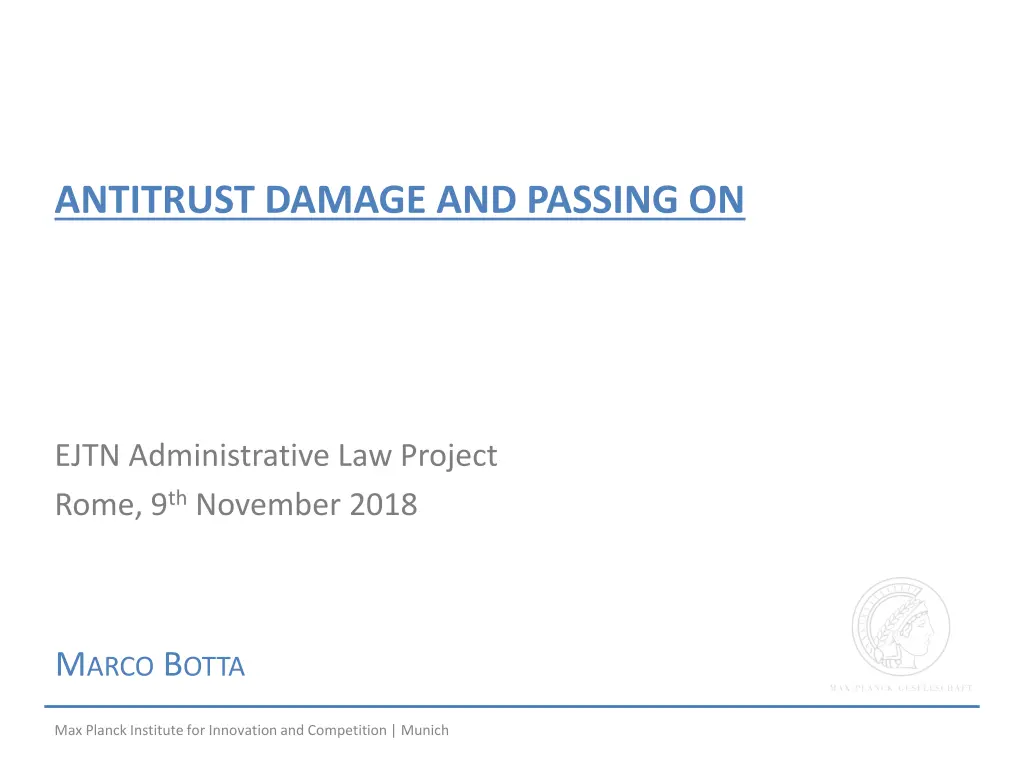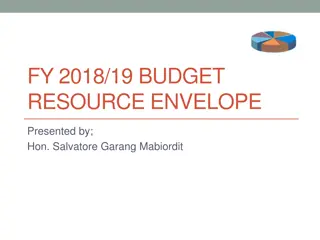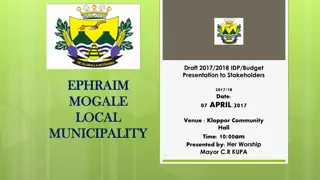
Antitrust Damage and Passing On: Methods and Legal Framework in EU Competition Law
Understanding the intricacies of antitrust damage quantification and passing on within the legal framework of EU competition law. Explore methods used to estimate damage, types of harm, claiming compensation, key directives, and a practical guide for calculating antitrust damages.
Download Presentation

Please find below an Image/Link to download the presentation.
The content on the website is provided AS IS for your information and personal use only. It may not be sold, licensed, or shared on other websites without obtaining consent from the author. If you encounter any issues during the download, it is possible that the publisher has removed the file from their server.
You are allowed to download the files provided on this website for personal or commercial use, subject to the condition that they are used lawfully. All files are the property of their respective owners.
The content on the website is provided AS IS for your information and personal use only. It may not be sold, licensed, or shared on other websites without obtaining consent from the author.
E N D
Presentation Transcript
ANTITRUST DAMAGE AND PASSING ON EJTN Administrative Law Project Rome, 9thNovember 2018 MARCO BOTTA Max Planck Institute for Innovation and Competition | Munich
Outline Damage quantification / passing on the legal framework in EU competition law. Overview of the methods relied by the economists to estimate the antitrust damage and passing on. Conclusions. 2 Max Planck Institute for Innovation and Competition | Munich
The Legal frame work 3 Max Planck Institute for Innovation and Competition | Munich
Antitrust damage The logic of the antitrust damage: 1) Art. 101-102 TFEU grant a right to un-distorted competition to individuals. 2) Victims of a breach of Art. 101-102 TFEU should be compensated. Types of harm : 1) Increase in prices (e.g. price fixing, market sharing, output limitation, excessive pricing) common in follow-on actions for cartels. 2) Exclusionary practices (e.g. margin squeeze, predatory pricing, tying, exclusivity agreements) stand alone actions for abuse of dominance. Decreased product quality and innovation very difficult to estimate. 3) 4 Max Planck Institute for Innovation and Competition | Munich
How to claim damage compensation Civil law jurisdictions Common law jurisdictions Civil law jurisdictions Breach of the law = breach Art. 101-102 TFEU Breach of statutory duty Fault Right to compensation for individuals Art. 17(2) Damages Directive: rebuttable presumption that cartel causes a damage NO prove of fault Damage Damage Causal link Causal link 5 Max Planck Institute for Innovation and Competition | Munich
From Manfredi to the Damages Directive Manfredi (C-295/04) first ECJ ruling on antitrust damage: 1) Principle of equivalence: EU MS that allow punitive damages should also recognize them for antitrust damage actions. 2) Principle of effectiveness: damage compensation in all EU Member States should include at least 3 components full compensation : a) Damnum emergens: reduction of claimant s assets. b) Lucrum cessans: loss of profits. c) Interest rate. Damages Directive (2014/104/EU): 1) Principle of full compensation (Art. 3.1) = codification Manfredi. 2) Prohibition of overcompensation (Art. 3.3) = overruling Manfredi. 6 Max Planck Institute for Innovation and Competition | Munich
Practical Guide Published by the EU Commission in June 2013 together with the draft Damages Directive. Objective: summary of the main economic theories/techniques to calculate antitrust damage. Legal value: soft law NOT binding. Practical value: increasingly relied by civil courts to check the methods used by economists hired by the parties. 7 Max Planck Institute for Innovation and Competition | Munich
Transfer of the damage / Passing on Producer: Cartel /single producer abusing its dominant position Price increase = price overcharge passed to direct purchaser Direct customer: wholesaler/retailer buy from the producer the products affected by anti-competitive practice Price increase = price overcharge passed to indirect purchaser Indirect customer: final customer buys the products affected by anti- competitivepractice and it bears the price overcharge
Recongnition passing on in EU competition law Manfredi: any individual can claim compensation for the harm suffered where there is a causal relationship between that harm and an agreement or practice prohibited under Article 101 [or Article 102] TFEU. (para. 61). 1) Damage quantification part of the damage is transferred downstream; Consequences passing on: 2) Legal standing: a) Indirect customer has legal standing if he/she proves that the direct customer has transferred downstream; b) Passing on defence: in a damage compensation action started by the direct customer, the producer can argue that the direct customer has transfered the price overcharge to the indirect customer direct customer has NO legal standing. the price overcharge 10 Max Planck Institute for Innovation and Competition | Munich
Passing on in Damages Directive Manfredi codified in Art. 12-14 Damages Directive. 1) 2) 3) Art. 13, rebuttable presumption of legal standing of indirect customers: Defendant breached EU competition law. Breach of competition law resulted in price overcharge. The indirect customer purchased goods or services that were the object of the infringement of the competition law.... or containing them . Defedant can rebut the presumption of legal standing (i.e. competition law breach did not cause any price overcharge). Draft Guidelines Passing On (June 2018) subject to public consultation: 1) Art. 16 Damages Directive: the EU Commission shall issue guidelines on methods of quantification of passing on. 2) Soft law NOT binding, like the Practical Guide. 11 Max Planck Institute for Innovation and Competition | Munich
Recognition passing on by national courts Principle of passing on recognized by national courts in ALL selected jurisdictions before the Damages Directive: 1) Supreme Courts (Germany - ORWI; France - Le Gouessant and Doux Aliments). 2) Competition Law Tribunal (UK Sainsbury). 3) Appelate civil courts (Italy Indaba and Unimar). 1) ECJ: enlarging number of potential claimants strenghtening effective enforcement EU competition law. 2) National courts: passing on reflects compensatory nature of civil damage actions compensatio lucri cum damno. Rationale recognition passing on: Max Planck Institute for Innovation and Competition, Munich 12
13 Passing on in national courts burden of proof Most of the cases in national courts concern passing on defence, rather than standing indirect customers. Diverging approaches followed by national courts in comparison to the Damages Directive: Rejection burden of proof concerning passing on the defendant (Le Gouessant; Indaba and Unimar). Rejection legal presumption that facilitates standing indirect customers (ORWI; Sainsbury). 1) 2) Art. 13-14 Damages Directive implemented in ALL EU Member States, BUT national courts will have to reconcile provisions of the Damages Directive with previous national case law. Max Planck Institute for Innovation and Competition, Munich 13
Overview of the economic methods 14 Max Planck Institute for Innovation and Competition | Munich
But-for counterfactual scenario Objective of compensation: place the injured party in the position in which it would have been in the absence of the infringement ( but-for - counterfactual scenario ). The antitrust damage is estimated as the difference between the actual and counterfactual values during the period of the competition law infringement. Main challenge in damage estimation: to exclude variables not related to the infringement co-founding factors (e.g. inflation, supply shortage, demand fluctuations). 15 Max Planck Institute for Innovation and Competition | Munich
Methods to estimate the counterfactual scenario Main methods: 1) Comparator-based. 2) Finance-based. 3) Cost-plus. 4) Simulation. How to choose the right method: 1) Type/amount of available data. 2) Theory of harm. 16 Max Planck Institute for Innovation and Competition | Munich
Comparator-based methods Main methods applied in practice and recommended by the Practical Guide. Variables of comparison taken in consideration: 1) Before-and-after method: comparison of the prices in the relevant market before and after the competition law violation. 2) Benchmark method: comparison with prices in similar product and geographic markets during the period of the infringement. Main problems: 1) Data availability during the entire period of the infringement. 2) Probative value of the benchmark. 17 Max Planck Institute for Innovation and Competition | Munich
Comparator-based-methods Before and after method Benchmark method 18 Max Planck Institute for Innovation and Competition | Munich
Cost-plus method Counterfactucal price: production costs + reasonable mark-up Main problems: 1) What costs should be considered (e.g. marginal, variables )? Should a certain proportion of sunk costs be included in the calculation? 2) How to allocate common costs to different categories of products. 3) Production costs may be inflated, due to the competition law infringement. 4) What is a a reasonable mark-up (e.g. competitors)? Cost-plus methods are often applied to estimate counterfactual price in regulated industries (e.g. telecommunication, energy, water). 19 Max Planck Institute for Innovation and Competition | Munich
Finance-based methods Logic: comparison of the profitability of the harmed undertaking in the actual and counterfactual scenario Three main methods: 1) Direct estimation of profitability (e.g. return on capital employed to assess the firm s profitability). 2) Method of financial multiples: comparison with the performance of other firms with similar risk/return profiles not affected by the infringement. 3) Event studies: changes in share prices triggered by events related to the infringement. Strength: finance-based methods require limited amount of data Weakness: they are more speculative weaker probative value 20 Max Planck Institute for Innovation and Competition | Munich
Simulation methods Logic: build the counterfactual scenario on the basis of a structural model (i.e. set of equations) Models are based on: 1) explicit assumptions (e.g., number of players, economies of scale, type of competitive interaction). 2) a number of parameters taken from the actual market in question. Main problem: assumptions and parameters taken in consideration can be arbitrary limited probative value. 21 Max Planck Institute for Innovation and Competition | Munich
Passing-on estimation Passing-on: difference of the downstream price with and without passing on. Co-founding factors that affect degree of passing on: 1) Degree of competition in the downstream market (e.g. number of competitors of the direct customer). 2) Buyer power of the indirect customer. 3) Demand/supply elasticity. 4) Value of the product subject to price overcharge in the production chain. 22 Max Planck Institute for Innovation and Competition | Munich
Evidence of passing on Quantitative evidence: estimation counterfactual downstream price same techniques used to estimate but-for scenario in a damage case (e.g. benchmark method comparison price trends in a similar market not affected by the passing on). Qualitative evidence: 1) Contracts and correspondence between direct and indirect customers. 2) Financial and accounting documentation. 3) Internal documents on prices (e.g. pricing models). 4) Witness statement from business people involved in pricing of products. 5) In regulated industries, documents concerning prices setting and price caps. 23 Max Planck Institute for Innovation and Competition | Munich
Volume effect Impact passing on damage estimation: 1) Overcharge effect: increased profits for direct customers. 2) Volume effect: decreased sales for direct customers. Damage: overcharge price passing on effect + volume effect. Passing on requires a complex estimation : US Supreme Court excluded passing on in US antitrust law since 1970s (Hannover Shoes; Illinois Brick) it is more efficient to limit claims to direct customers. 24 Max Planck Institute for Innovation and Competition | Munich
Conclusions ECJ case law and Damages Directive recognize principles of full compensation and passing on = compensatory goal. Increasing relevance of economists civil judges can rely on the EU Commission guidelines to assess the economists estimations. Same methods to estimate damage and passing on scenario. counter-factual Selection of the method depends on the types/amount of data available: comparator-based methods are the most reliable, but they require a consistent set of price data during the period of the infringement. 25 Max Planck Institute for Innovation and Competition | Munich
Thank you very much for your attention! marco.botta@ip.mpg.de 26 Max Planck Institute for Innovation and Competition | Munich






















